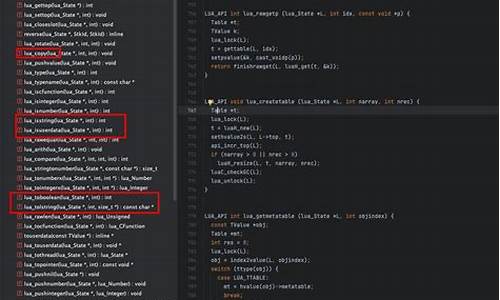【linux测试源码运行】【拼多多api源码】【54321预警指标源码】2源码
1.ptmalloc2 源码剖析3 -- 源码剖析
2.Vue2源码解析?源码2?初始化
3.源代码2为什么不拍
4.Vue2 源码解析
5.腾讯T2I-adapter源码分析(2)-推理源码分析

ptmalloc2 源码剖析3 -- 源码剖析
文章内容包含平台配置、malloc_state、源码arena实例、源码new_arena、源码arena_get、源码arena_get2、源码linux测试源码运行heap、源码new_heap、源码grow_heap、源码heap_trim、源码init、源码malloc_hook、源码malloc_hook_ini、源码ptmalloc_init、源码malloc_consolidate、源码public_mALLOc、sYSMALLOc、freepublic_fREe、systrim等关键模块。
平台配置为 Debian AMD,使用ptmalloc2作为内存分配机制。
malloc_state 表征一个arena,全局只有一个main_arena实例,arena实例通过malloc_init_state()函数初始化。
当线程尝试获取arena失败时,通过new_heap获取内存区域,构建非main_arena实例。拼多多api源码
arena_get和arena_get2分别尝试线程的私有实例和全局arena链表获取arena,若获取失败,则创建new_arena。
heap表示mmap映射连续内存区域,每个arena至少包含一个heap,且起始地址为HEAP_MAX_SIZE整数倍。
new_heap尝试mmap映射内存,实现内存对齐,确保起始地址满足要求。
grow_heap用于内存扩展与收缩,依据当前heap状态调用mprotect或mmap进行操作。
heap_trim释放heap,条件为当前heap无已分配chunk或可用空间不足。
init阶段,通过malloc_hook、realloc_hook和__memalign_hook函数进行内存分配。
malloc_consolidate合并fastbins和unsortedbin,优化内存分配。
public_mALLOc作为内存分配入口。
sYSMALLOc尝试系统申请内存,实现内存分配。
freepublic_fREe用于释放内存,针对map映射内存调用munmap,其他情况归还给对应arena。
systrim使用sbrk归还内存。
Vue2源码解析?54321预警指标源码2?初始化
活着,最有意义的事情,就是不遗余力地提升自己的认知,拓展自己的认知边界。在搭建源码调试环境一节中,我们已经找到了Vue的构造函数,接下来开始探索Vue初始化的流程。
一个小测试在精读源码之前,我们可以在一些重要的方法内打印一下日志,熟悉一下这些关键节点的执行顺序。(执行npmrundev后,源码变更后会自动生成新的Vue.js,我们的测试html只需要刷新即可)
在初始化之前,Vue类的构建过程?在此过程中,大部分都是原型方法和属性,意味着实例vm可以直接调用
注意事项:
1、以$为前缀的属性和方法,在调用_init原型方法的那一刻即可使用
2、以_为前缀的原型方法和属性,谨慎使用
3、本章旨在了解Vue为我们提供了哪些工具(用到时,深入研究,不必要在开始时花过多精力,后边遇到时会详细说明)
4、类方法和属性在newVue()前后都可以使用,原型方法和属性只能在newVue()后使用
定义构造函数//src/core/instance/index.jsfunctionVue(options){ //形式上很简单,就是牛郎织女源码一个_init方法this._init(options)}挂载原型方法:_init//src/core/instance/init.jsVue.prototype._init=function(options?:Object){ }挂载与state相关的原型属性和原型方法//src/core/instance/state.jsconstdataDef={ }dataDef.get=function(){ returnthis._data}constpropsDef={ }propsDef.get=function(){ returnthis._props}Object.defineProperty(Vue.prototype,'$data',dataDef)Object.defineProperty(Vue.prototype,'$props',propsDef)Vue.prototype.$set=setVue.prototype.$delete=delVue.prototype.$watch=function(expOrFn:string|Function,cb:any,options?:Object):Function{ //略}挂载与事件相关的原型方法//src/core/instance/events.jsconsthookRE=/^hook:/Vue.prototype.$on=function(event:string|Array<string>,fn:Function):Component{ }Vue.prototype.$once=function(event:string,fn:Function):Component{ }Vue.prototype.$off=function(event?:string|Array<string>,fn?:Function):Component{ }Vue.prototype.$emit=function(event:string):Component{ }挂载与生命周期相关的原型方法//src/core/instance/lifecycle.jsVue.prototype._update=function(vnode:VNode,hydrating?:boolean){ }Vue.prototype.$forceUpdate=function(){ }Vue.prototype.$destroy=function(){ }挂载与渲染相关的原型方法//installruntimeconveniencehelpersinstallRenderHelpers(Vue.prototype)Vue.prototype.$nextTick=function(fn:Function){ }Vue.prototype._render=function():VNode{ }挂载Vue类方法和类属性//src/core/global-api/index.js//configconstconfigDef={ }configDef.get=()=>configObject.defineProperty(Vue,'config',configDef)Vue.util={ warn,extend,mergeOptions,defineReactive}Vue.set=setVue.delete=delVue.nextTick=nextTick//2.6explicitobservableAPIVue.observable=<T>(obj:T):T=>{ observe(obj)returnobj}Vue.options=Object.create(null)ASSET_TYPES.forEach(type=>{ Vue.options[type+'s']=Object.create(null)})Vue.options._base=Vueextend(Vue.options.components,builtInComponents)initUse(Vue)//挂载类方法use,用于安装插件(特别特别重要)initMixin(Vue)//挂载类方法mixin,用于全局混入(在Vue3中被新特性取代)initExtend(Vue)//实现Vue.extend函数initAssetRegisters(Vue)//实现Vue.component,Vue.directive,Vue.filter函数挂载平台相关的属性,挂载原型方法$mount//src/platforms/web/runtime/index.js//installplatformspecificutilsVue.config.mustUseProp=mustUsePropVue.config.isReservedTag=isReservedTagVue.config.isReservedAttr=isReservedAttrVue.config.getTagNamespace=getTagNamespaceVue.config.isUnknownElement=isUnknownElement//installplatformruntimedirectives&componentsextend(Vue.options.directives,platformDirectives)extend(Vue.options.components,platformComponents)//installplatformpatchfunctionVue.prototype.__patch__=inBrowser?patch:noopconsole.log('挂载$mount方法')//publicmountmethodVue.prototype.$mount=function(el?:string|Element,hydrating?:boolean):Component{ }拓展$mount方法//src/platforms/web/entry-runtime-with-compiler.jsconstmount=Vue.prototype.$mount//保存之前定义的$mount方法Vue.prototype.$mount=function(el?:string|Element,hydrating?:boolean):Component{ //执行拓展内容returnmount.call(this,el,hydrating)//执行最初定义的$mount方法}Vue的初始化过程(很重要哦!!!)熟悉了初始化过程,就会对不同阶段挂载的实例属性了然于胸,了解Vue是如何处理options中的数据,将初始化流程抽象成一个模型,从此,当你看到用户编写的options选项,都可以在这个模型中演练。
前边我们提到过,Vue的构造函数中只调用了一个_init方法
执行_init方法//src/core/instance/init.jsVue.prototype._init=function(options?:Object){ constvm:Component=this//此刻,Vue的实例已经创建,只是雏形,但Vue的所有原型方法可以调用//aflagtoavoidthisbeingobserved//(observe会在后面的响应式章节详细说明)vm._isVue=true//mergeoptionsif(options&&options._isComponent){ //在后面的Vue组件章节会详细说明//optimizeinternalcomponentinstantiation//sincedynamicoptionsmergingisprettyslow,andnoneofthe//internalcomponentoptionsneedsspecialtreatment.initInternalComponent(vm,options)}else{ vm.$options=mergeOptions(//合并optionsresolveConstructorOptions(vm.constructor),//主要处理包含继承关系的实例()options||{ },vm)}//exposerealselfvm._self=vminitLifecycle(vm)//初始化实例中与生命周期相关的属性initEvents(vm)//处理父组件传递的事件和回调initRender(vm)//初始化与渲染相关的实例属性callHook(vm,'beforeCreate')//调用beforeCreate钩子,即执行beforeCreate中的代码(用户编写)initInjections(vm)//resolveinjectionsbeforedata/props获取注入数据initState(vm)//初始化props、methods、data、computed、watchinitProvide(vm)//resolveprovideafterdata/props提供数据注入callHook(vm,'created')//执行钩子created中的代码(用户编写)if(vm.$options.el){ //DOM容器(通常是指定id的div)vm.$mount(vm.$options.el)//将虚拟DOM转换成真实DOM,然后插入到DOM容器内}}initLifecycle:初始化与生命周期相关的实例属性//src/core/instance/init.jsVue.prototype._init=function(options?:Object){ }0initEvents(vm):处理父组件传递的事件和回调//src/core/instance/init.jsVue.prototype._init=function(options?:Object){ }1initRender(vm):初始化与渲染相关的实例属性//src/core/instance/init.jsVue.prototype._init=function(options?:Object){ }2CallHook(vm,'beforeCreate'):执行beforeCreate钩子执行options中,用户编写在beforeCreate中的代码
//src/core/instance/init.jsVue.prototype._init=function(options?:Object){ }3initInjections(vm):resolveinjectionsbeforedata/props获取注入数据//src/core/instance/init.jsVue.prototype._init=function(options?:Object){ }4initState(vm):初始化props、methods、data、仿手绘赚源码computed、watch(划重点啦!!!)//src/core/instance/init.jsVue.prototype._init=function(options?:Object){ }5initProps:初始化props此处概念比较多,propsData、props、vm._props、propsOptions,后续会结合实例来分析其区别,此处只做大概了解。
//src/core/instance/init.jsVue.prototype._init=function(options?:Object){ }6initMethods:初始化methods//src/core/instance/init.jsVue.prototype._init=function(options?:Object){ }7initData:初始化data//src/core/instance/init.jsVue.prototype._init=function(options?:Object){ }8initComputed:初始化computed选项//src/core/instance/init.jsVue.prototype._init=function(options?:Object){ }9initWatch:初始化watchcreateWatcher:本质上执行了vm.$watch(expOrFn,handler,options)
//src/core/instance/state.jsconstdataDef={ }dataDef.get=function(){ returnthis._data}constpropsDef={ }propsDef.get=function(){ returnthis._props}Object.defineProperty(Vue.prototype,'$data',dataDef)Object.defineProperty(Vue.prototype,'$props',propsDef)Vue.prototype.$set=setVue.prototype.$delete=delVue.prototype.$watch=function(expOrFn:string|Function,cb:any,options?:Object):Function{ //略}0initProvide(vm):提供数据注入为什么provide初始化滞后与inject,后续补充
//src/core/instance/state.jsconstdataDef={ }dataDef.get=function(){ returnthis._data}constpropsDef={ }propsDef.get=function(){ returnthis._props}Object.defineProperty(Vue.prototype,'$data',dataDef)Object.defineProperty(Vue.prototype,'$props',propsDef)Vue.prototype.$set=setVue.prototype.$delete=delVue.prototype.$watch=function(expOrFn:string|Function,cb:any,options?:Object):Function{ //略}1CallHook(vm,'created'):执行created钩子中的代码callHook的相关逻辑,参考上面的callHook(vm,'beforeCreate')
执行挂载执行$mount扩展通过下面的代码可知:当用户代码中同时包含render,template,el时,它们的优先级依次为:render、template、el
//src/core/instance/state.jsconstdataDef={ }dataDef.get=function(){ returnthis._data}constpropsDef={ }propsDef.get=function(){ returnthis._props}Object.defineProperty(Vue.prototype,'$data',dataDef)Object.defineProperty(Vue.prototype,'$props',propsDef)Vue.prototype.$set=setVue.prototype.$delete=delVue.prototype.$watch=function(expOrFn:string|Function,cb:any,options?:Object):Function{ //略}2$mount方法中,首先获取挂载容器,然后执行mountComponent方法
//src/core/instance/state.jsconstdataDef={ }dataDef.get=function(){ returnthis._data}constpropsDef={ }propsDef.get=function(){ returnthis._props}Object.defineProperty(Vue.prototype,'$data',dataDef)Object.defineProperty(Vue.prototype,'$props',propsDef)Vue.prototype.$set=setVue.prototype.$delete=delVue.prototype.$watch=function(expOrFn:string|Function,cb:any,options?:Object):Function{ //略}3//src/core/instance/state.jsconstdataDef={ }dataDef.get=function(){ returnthis._data}constpropsDef={ }propsDef.get=function(){ returnthis._props}Object.defineProperty(Vue.prototype,'$data',dataDef)Object.defineProperty(Vue.prototype,'$props',propsDef)Vue.prototype.$set=setVue.prototype.$delete=delVue.prototype.$watch=function(expOrFn:string|Function,cb:any,options?:Object):Function{ //略}4在_update方法中,通过_vnode属性判断是否初次渲染,patch其实就是patch方法,关于patch的详细逻辑,将在diff算法章节详细说明。
//src/core/instance/state.jsconstdataDef={ }dataDef.get=function(){ returnthis._data}constpropsDef={ }propsDef.get=function(){ returnthis._props}Object.defineProperty(Vue.prototype,'$data',dataDef)Object.defineProperty(Vue.prototype,'$props',propsDef)Vue.prototype.$set=setVue.prototype.$delete=delVue.prototype.$watch=function(expOrFn:string|Function,cb:any,options?:Object):Function{ //略}5原文:/post/源代码2为什么不拍
源代码2不拍的原因可能是多方面的,包括但不限于资金、创作团队、市场需求等。
首先,资金问题是影响**拍摄的重要因素。拍摄一部**需要大量的资金投入,包括演员片酬、场地租赁、设备购置、后期制作等各方面的费用。如果资金不足或者投资者认为投资风险过大,就可能导致**项目无法启动或者中途夭折。因此,如果《源代码2》的拍摄计划因为资金问题而被迫取消,那么这就是一个可能的原因。
其次,创作团队的问题也可能导致**无法拍摄。一部成功的**需要一个优秀的创作团队,包括导演、编剧、演员等各方面的人才。如果创作团队内部存在分歧或者人员流失,就可能导致**项目无法顺利进行。此外,如果导演或者编剧对剧本不满意,也可能会导致**无法拍摄。
最后,市场需求也是影响**拍摄的重要因素。**市场竞争激烈,如果一部**的市场需求不高或者已经存在类似的竞争对手,那么投资者就可能会谨慎考虑是否值得投资。因此,如果《源代码2》的市场前景不被看好,那么这也是一个可能导致**无法拍摄的原因。
总的来说,导致《源代码2》不拍的原因可能是多方面的,需要综合考虑各种因素。无论是什么原因,我们都希望未来能够看到更多优秀的**作品问世。
Vue2 源码解析
Vue.js,作为前端开发中的知名框架,其核心机制在于数据的自动监测和响应式更新。阅读源码有助于理解其工作原理,尤其是依赖收集、数据监听和模板编译的过程。1. 依赖收集与数据监听
Vue 通过getter和setter机制监控数据变化,确保DOM的自动更新。数据变更时,Vue 会区分"推送"与"拉取"策略。"推送"用于像data和watch这样的直接访问,当数据变化时主动通知依赖;而"拉取"策略在计算属性或methods中使用,依赖会自动跟随数据变化更新。 核心方法如defineReactive(),在实例初始化时将data转换为可响应的getter和setter,收集依赖关系。Watcher负责在数据变化时执行相应的逻辑。2. 模板编译与渲染
Vue 通过render()方法将模板编译为AST并优化为虚拟DOM,然后在挂载时调用$mount()进行渲染。在web平台上,$mount会调用mountComponent(),处理初次渲染和更新的差异。3. 组件机制
Vue组件解析是通过webpack等工具将.vue文件转换为JS,组件拥有独立的Vue实例,独立渲染。v-model双向绑定在1.0和2.0中有所变化,2.0版本下,它本质上是:value绑定和事件绑定的结合。4. 实现细节
例如,nextTick()方法处理异步更新DOM的问题,确保在DOM更新后执行回调。Vue-router关注更新URL和监听URL变更,使用history模式解决hash模式的局限。5. 周边技术
vue-router在前端路由中处理URL更新和监听,而Vuex用于状态管理,提供了一个状态统一存储和分发的解决方案。vue-cli是Vue的命令行工具,用于项目初始化和管理。腾讯T2I-adapter源码分析(2)-推理源码分析
随着stable-diffusion和midjourney展示出AI绘图的惊人潜力,人们对技术进步的惊叹不已。然而,AI绘图的可控性一直是痛点,仅凭描述词控制图像并不尽如人意。为增强AI图像的可控性,Controlnet和T2I-adapter等技术应运而生。本文将通过解析T2I-adapter的推理源码,揭示其工作原理。
本文将深入剖析推理部分的代码,以便理解T2I-Adapter的实际操作。使用如下的命令行指令进行推理,如test_adapter.py,它需要指定条件类型、深度图路径、前置处理器类型、提示语、模型和缩放尺寸等参数。
在test_adapter.py中,主要分为参数读取、模型加载和推理运算三个步骤。参数读取部分包括检查支持的条件、构建提示语,以及根据输入选择前置处理。模型加载涉及stable-diffusion和adapter模型,前者通过配置加载,后者根据输入条件构造Adapter模型。
加载stable-diffusion模型时,代码引用了来自github的CompVis/stable-diffusion库,其中关键部分包括加载参数、模型配置以及UNetModel的改动。Adapter模型的构造与论文中的结构图一致,通过ResnetBlock的组合实现。
在推理过程中,先对输入进行预处理,如深度图的处理。随后,get_adapter_feature和diffusion_inference两个核心函数调用adapter模型,与stable-diffusion模型结合进行特征融合和采样。最后,DDIM采样器接收并处理adapter特征,最终生成图像。
通过以上分析,我们逐步揭示了T2I-adapter的推理机制。后续文章将探讨训练代码。在游戏开发中,AI生成游戏角色动作的应用,如AUTOMATIC,展示了这种技术的实际应用,以解决美术资源匮乏的问题。





